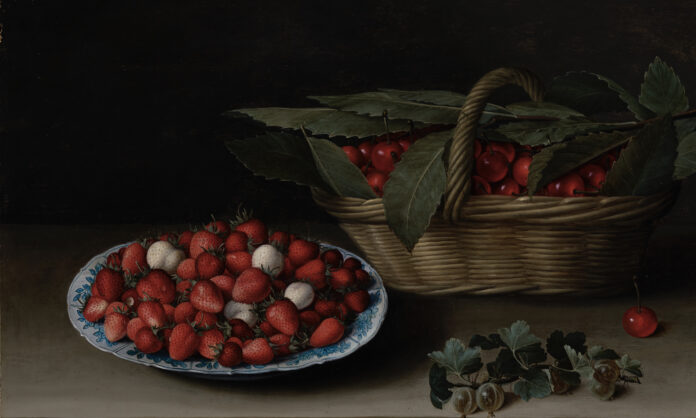The Kimbell Art Museum has acquired a rare 17th century masterpiece by French artist Louise Moillon and is making the painting accessible to the public for the first time in its history.
Still Life with a Bowl of Strawberries, Basket of Cherries, and Branch of Gooseberries, signed and dated 1631 by Moillon, went on display Friday (Nov. 18). The painting, one of only a few by Moillon in American museums, was unknown to scholars until its appearance at auction in March. The Kimbell purchased the painting from an American collector through the New York dealer Adam Williams.
“The Kimbell Art Museum is delighted to add to its renowned collection what is unquestionably a masterpiece by Louise Moillon,” said Eric Lee, director of the Kimbell. “The painting is an exceptionally well-preserved composition, a mysterious image of simple fruits painted in jewel tones on a wooden panel. It came to light for the first time just this year and is a prime example of Moillon’s keen observational skills and poetic approach to still life.”
The painting joins another striking and innovative still life by a woman, Still Life with Mackerel (1787) by Anne Vallayer-Coster, acquired by the Kimbell in 2019.
Louise Moillon, who has been called the “unexpected genius of the period,” was among the greatest French still-life painters of the 17th century, the Kimbell said, creating paintings that “are remarkable for their elegance and restraint, the equilibrium of their compositions and a delicate technique that reveals the qualities of fresh, ripe fruits and vegetables, provoking a sense of serenity.”
Although the work of many painters of the period, especially female artists, remains unattributed, Louise Moillon signed and dated many of her pictures, enabling about 60 still lifes to be assigned to her hand. (She signed the Kimbell canvas with the archaic spelling of her name, Louyse.) Much remains unknown about her career, but archival documents show that Moillon, who lived from 1609 or 1610 untl 1696, earned renown in her own time. Five of her paintings of fruits are listed in the inventory of King Charles I of England (1600–1649).
Meticulously painted on oak panel, the Kimbell still life shows Moillon’s characteristic restraint, highlighting the appeal of the delectable fruit at its prime – ripe, firm and succulent. The fruit containers are placed on a closely framed wooden tabletop that tilts slightly forward and whose edge is brought near the foreground. A strong light from the upper left illuminates the glistening red objects against a dark, shadowy background. Throughout the composition, Moillon creates a simple yet sophisticated balance of color and tone.
Moillon’s sincere approach to still life – excluding anecdote and symbolism – reflects 17th-century French agricultural reforms and the keen market in Paris for fresh fruit and vegetables. The nobility and bourgeoisie took pride in the fresh produce cultivated in their country estates and gardens. In the fields and orchards that abounded in the countryside outside the capital, women and children would pick the fruit late in the day so that it could be transported to the city by morning and sold at market.
The peaches, plums, apricots, grapes, cherries and wild strawberries, along with vegetables such as artichokes and asparagus, that we see in Louise Moillon’s still lifes and market scenes represent the produce that would have been scrupulously selected for freshness and flavor by ladies, their cooks and their maidservants and proudly served at table.
The Moillon painting is the most recent of several acquisitions timed to the 50th anniversary of the Kimbell’s founding, including a bronze vessel from the Shang dynasty (c. 1600–1050 BC); a larger-than-life-sized sculpture, The Mountain (La Montagne), designed by Aristide Maillol in 1937 and posthumously cast; a 16th-century alabaster statue of the Virgin and Child, from the Atelier of Saint-Léger in Troyes, France; Dog Guarding a Basket of Grapes (1836), an impressive still life by Ferdinand Georg Waldmüller; and three pastels by Kimbell architect Louis I. Kahn.
Information for this article was provided by the Kimbell Art Museum.







